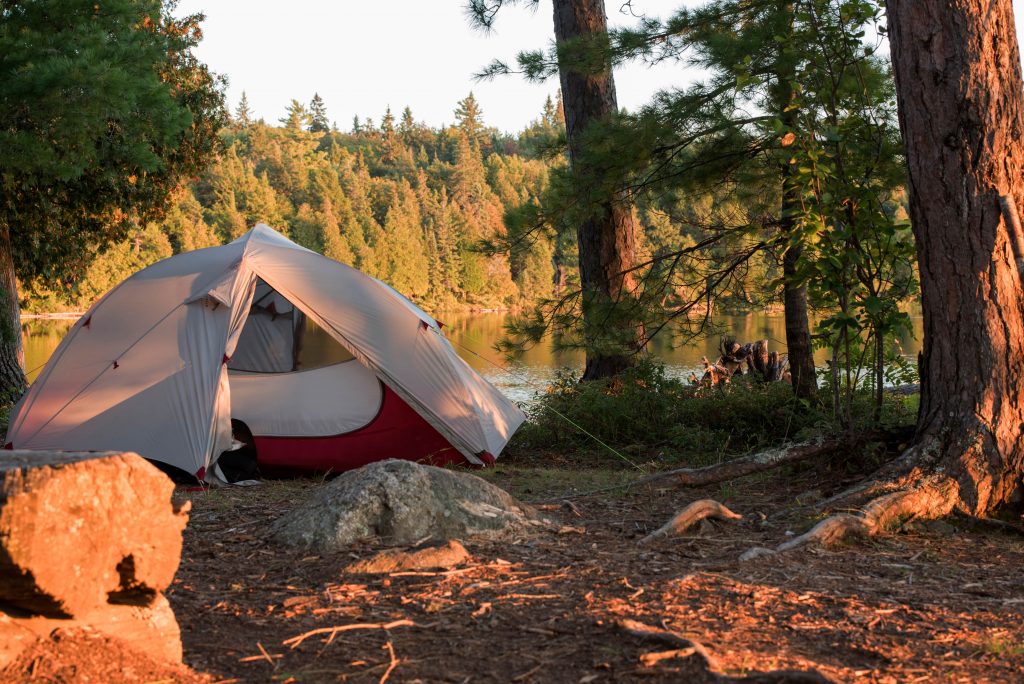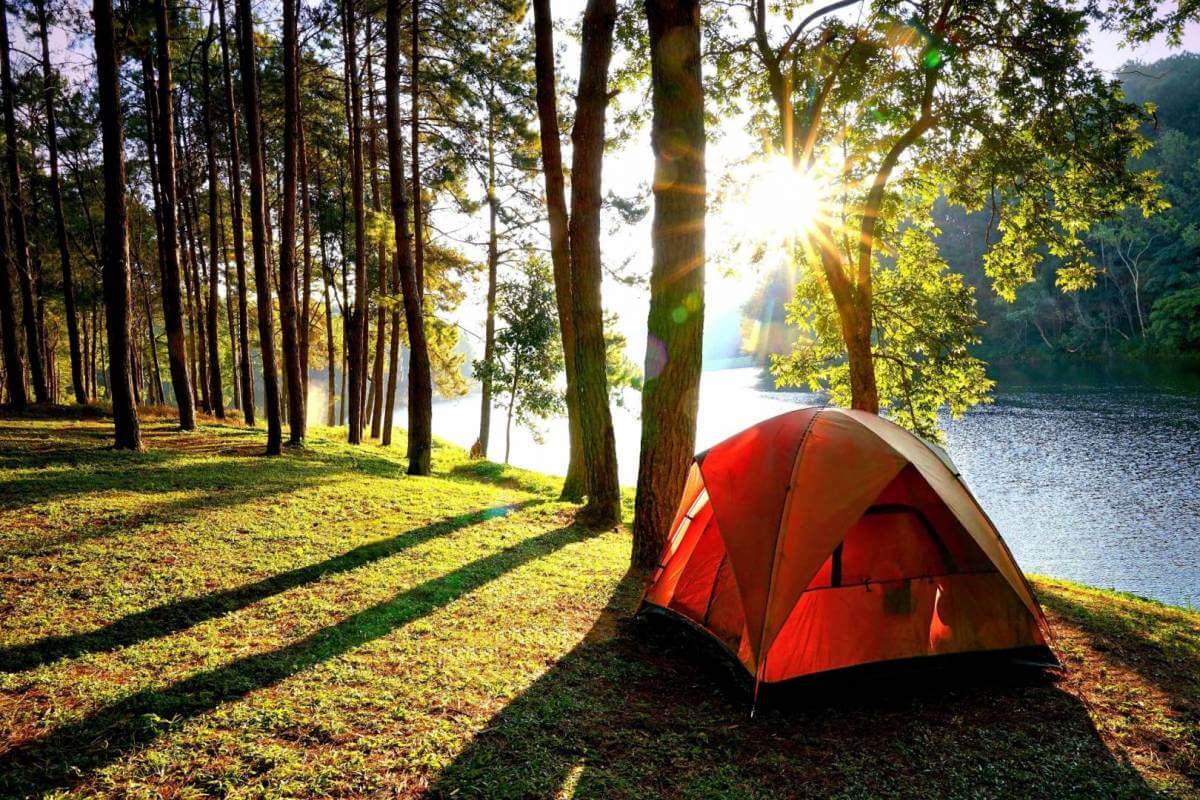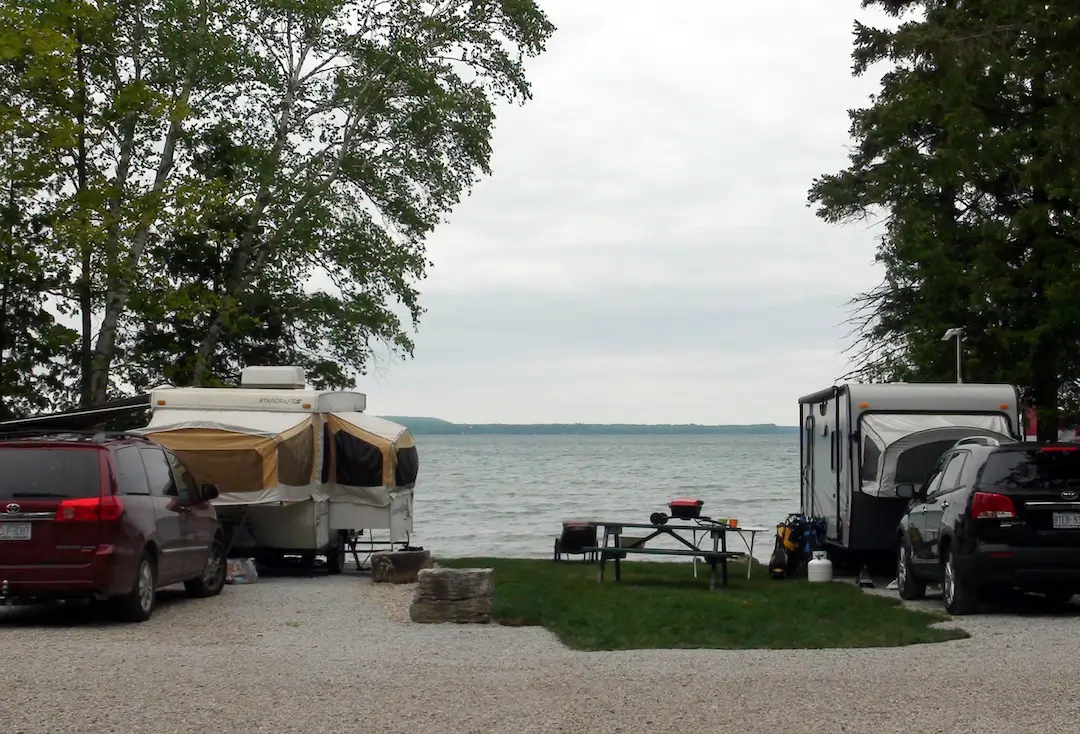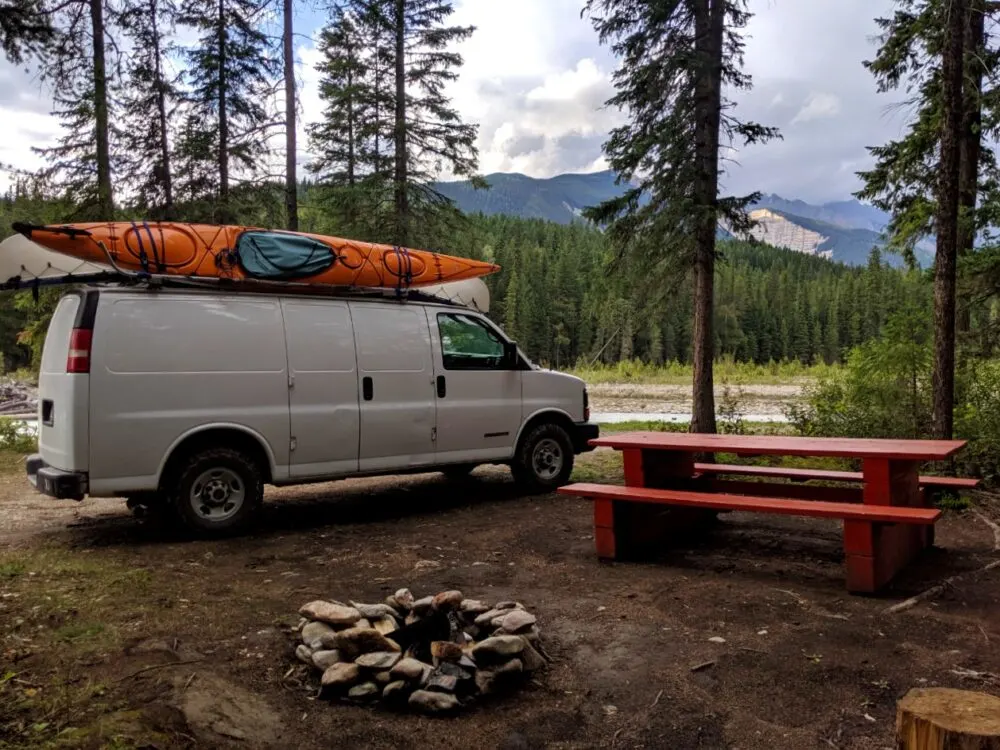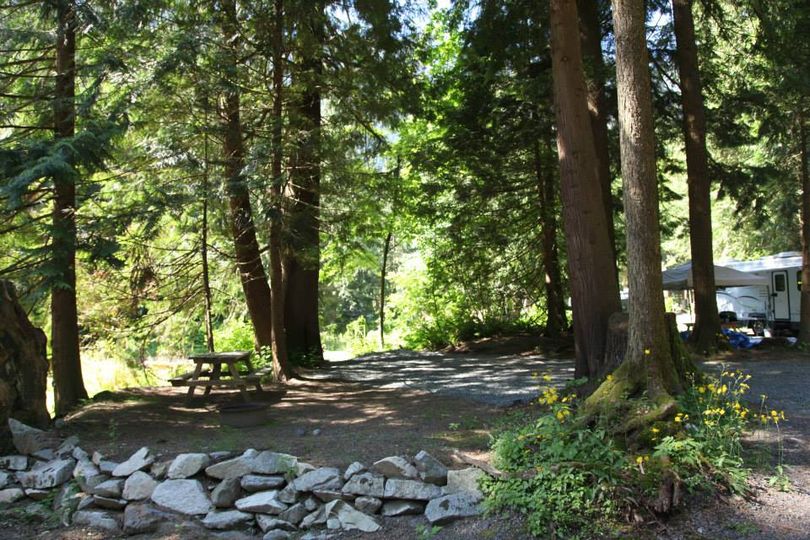Private campgrounds are the perfect way to escape the hustle and bustle of everyday life. The harsh winter weather and long hours in nature provide a welcome break from the office and an opportunity to explore Canada’s vast wilderness. If you’re planning a trip to a provincial or national park, check the campground reservations site at www.reservecanadas.gc.ca and make a reservation before making your way up to the campsite. It won’t cost anything, and it’s always good practice to show up early – especially on busy summer weekends when many visitors are eager to find their site or hike in.
Northern Ontario is an outdoor enthusiast’s paradise, offering some of Canada’s most stunning landscapes and natural wonders. From dense forests and pristine lakes to rugged mountains and winding rivers, this region is a haven for campers looking to escape the hustle and bustle of city life. If you plan a camping trip to Northern Ontario, you’ll be pleased to know that plenty of private campgrounds are scattered throughout the area. In this blog post, we’ll highlight some of the best private campgrounds in Northern Ontario.
The Best Private Campgrounds In Northern Ontario
Algonquin Provincial Park
Algonquin Provincial Park is one of the most popular camping destinations in Northern Ontario, attracting thousands of visitors each year. While the park is not a private campground, it has several privately owned campsites within its borders. These campsites offer a range of amenities, including electrical hookups, showers, and flush toilets. The park is home to over 2,400 lakes and 1,200 kilometres of streams and rivers, making it an ideal spot for fishing, canoeing, and kayaking.
Algonquin Provincial Park is a vast wilderness area in central Ontario, Canada. Spanning over 7,600 square kilometres, the park is home to a diverse range of wildlife, including moose, black bears, wolves, and beavers, over 2,400 lakes and 1,200 kilometres of streams and rivers. The park is also renowned for its stunning fall foliage, with visitors coming from all over the world to witness the vibrant display of colours.
Algonquin Provincial Park is a popular destination for outdoor enthusiasts, offering various recreational activities such as hiking, canoeing, fishing, and camping. The park boasts over 1,500 campsites spread across 21 campgrounds, ranging from backcountry sites accessible only by canoe or on foot to car camping sites with amenities such as electrical hookups, showers, and flush toilets.
In addition to camping, visitors to Algonquin Provincial Park can explore the park’s many hiking trails, ranging from short, easy walks to multi-day backpacking trips. Canoeing and kayaking are popular, with numerous lakes and rivers to explore. Fishing is another popular pastime, with the park’s lakes and streams teeming with trout, bass, and other fish species.
Algonquin Provincial Park is a must-visit destination for anyone seeking an authentic wilderness experience. With its stunning natural beauty, diverse wildlife, and endless recreational opportunities, it’s no wonder that the park attracts millions of visitors each year.
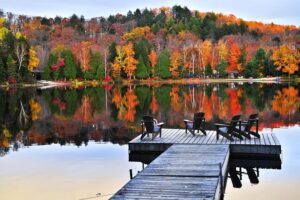
Killarney Provincial Park
Killarney Provincial Park is another popular camping destination in Northern Ontario. This park offers a range of camping options, including backcountry camping, car camping, and RV camping. The park is known for its stunning scenery, with towering cliffs and crystal-clear lakes providing a breathtaking backdrop for your camping trip. Several private campgrounds outside the park boundaries offer a range of amenities and services, including laundry facilities, swimming pools, and playgrounds.
The park covers an area of over 480 square kilometres and is known for its rugged landscapes, crystal-clear lakes, and stunning views. The park has diverse flora and fauna, including moose, black bears, wolves, and bald eagles.
Killarney Provincial Park is a popular destination for outdoor enthusiasts, offering a variety of recreational activities such as hiking, canoeing, kayaking, fishing, and camping. The park boasts over 645 campsites spread across several campgrounds, ranging from backcountry sites accessible only by canoe or on foot to car camping sites with amenities such as electrical hookups, showers, and flush toilets.
In addition to camping, visitors to Killarney Provincial Park can explore the park’s many hiking trails, ranging from short, easy walks to multi-day backpacking trips. The park is also renowned for its canoeing and kayaking opportunities, with numerous lakes and rivers to explore. Fishing is another popular activity, with the park’s lakes and streams teeming with trout, bass, and other fish species.
One of the highlights of Killarney Provincial Park is the stunning scenery, with its pink granite cliffs, white quartzite ridges, and crystal-clear lakes offering breathtaking views. The park is top-rated in the fall when the leaves of the maple and oak trees turn vibrant shades of red, orange, and gold.
Killarney Provincial Park is a must-visit destination for anyone seeking an authentic wilderness experience. With its rugged landscapes, diverse wildlife, and endless recreational opportunities, it’s no wonder that the park is considered one of the crown jewels of Ontario’s provincial park system.
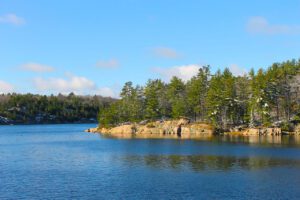
Lake Nipissing
Lake Nipissing is one of the largest lakes in Ontario, and it offers plenty of camping and outdoor recreation opportunities. Several private campgrounds are located around the lake, offering a range of camping options, from tent sites to full-service RV sites. Many campgrounds also offer boat rentals, allowing you to explore the lake’s many islands and secluded bays. Lake Nipissing is also a popular spot for fishing, with walleye, pike, and bass being among the most commonly caught fish in the area.
The lake is known for its crystal-clear water, sandy beaches, and excellent fishing opportunities.
Lake Nipissing is a popular destination for outdoor enthusiasts, offering various recreational activities such as boating, fishing, swimming, and camping. The lake is home to various fish species, including walleye, northern pike, muskie, and smallmouth bass, making it a popular destination for anglers. The lake also has many sandy beaches and parks perfect for swimming, picnicking, and sunbathing.
In addition to fishing and swimming, visitors to Lake Nipissing can explore the lake’s many islands and bays by boat or kayak. The lake also has several marinas and boat rental companies, making getting out on the water easy. The lake is famous for ice fishing, snowmobiling, and cross-country skiing in winter.
One of the highlights of Lake Nipissing is its natural beauty, with its clear waters, rocky shorelines, and lush forests providing a stunning backdrop for outdoor activities. The lake is also steeped in history, with several First Nations communities having lived in the area for thousands of years.
Lake Nipissing is a must-visit destination for anyone seeking a true outdoor adventure. With its pristine waters, abundant wildlife, and endless recreational opportunities, it’s no wonder that the lake is considered one of the crown jewels of Ontario’s natural beauty.
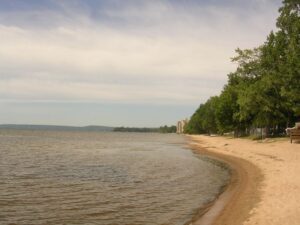
French River Provincial Park
French River Provincial Park is located along the historic French River, an important transportation route for centuries. The park offers a range of camping options, including backcountry camping, car camping, and RV camping. Several private campgrounds are located around the park, offering a range of amenities, including boat rentals, swimming pools, and mini-golf courses. The French River is also a popular spot for fishing, with pickerel and muskie being among the most commonly caught fish in the area.
It boasts over 110 square kilometres of rugged landscapes, clear waters, and diverse wildlife.
Outdoor enthusiasts flock to French River Provincial Park for various recreational activities, including hiking, canoeing, kayaking, fishing, and camping. The park has over 200 campsites across several campgrounds, ranging from backcountry sites to car camping sites, with amenities like electrical hookups, showers, and flush toilets.
Visitors can explore the park’s many hiking trails, which range from short, easy walks to multi-day backpacking trips. The park is also a haven for canoeing and kayaking enthusiasts, with numerous lakes and rivers to explore. Fishing is another popular activity, with the park’s lakes and streams teeming with trout, bass, and other fish species.
But what sets French River Provincial Park apart is its stunning scenery. The rugged hills, granite outcrops, and pristine waterways offer breathtaking views, and the park is home to diverse wildlife, including moose, black bears, beavers, and otters.
For anyone seeking an authentic wilderness experience, French River Provincial Park is a must-visit destination. With its endless recreational opportunities, diverse wildlife, and rugged landscapes, it’s no surprise that the park is considered one of the crown jewels of Ontario’s provincial park system.
Lake Superior Provincial Park
Lake Superior Provincial Park is located on the northeastern shore of Lake Superior and is known for its rugged terrain and stunning scenery. The park offers a range of camping options, including backcountry camping, car camping, and RV camping. Several private campgrounds are located outside the park boundaries, offering a range of amenities, including showers, laundry facilities, and playgrounds. The park is also home to several hiking trails, including the Coastal Trail, which offers stunning views of the lake and surrounding wilderness.
Lake Superior Provincial Park is a wilderness area located on the eastern shore of Lake Superior in Ontario, Canada. The park covers an area of over 1,550 square kilometres and is known for its rugged landscapes, clear waters, and diverse wildlife.
Lake Superior Provincial Park is a popular destination for outdoor enthusiasts, offering a variety of recreational activities such as hiking, camping, fishing, and canoeing. The park boasts over 1,500 campsites spread across several campgrounds, ranging from backcountry sites accessible only by canoe or on foot to car camping sites with amenities such as electrical hookups, showers, and flush toilets.
In addition to camping, Lake Superior Provincial Park visitors can explore the park’s many hiking trails, ranging from short, easy walks to multi-day backpacking trips. The park is also renowned for its canoeing and kayaking opportunities, with numerous lakes and rivers to explore. Fishing is another popular activity, with the park’s lakes and streams teeming with trout, salmon, and other fish species.
One of the highlights of Lake Superior Provincial Park is the stunning scenery, with its rugged hills, granite outcrops, and pristine waterways offering breathtaking views. The park is also home to diverse wildlife, including moose, black bears, wolves, and bald eagles.
Lake Superior Provincial Park is a must-visit destination for anyone seeking an authentic wilderness experience. With its rugged landscapes, diverse wildlife, and endless recreational opportunities, it’s no wonder that the park is considered one of the crown jewels of Ontario’s provincial park system.
Manitoulin Island
Manitoulin Island is the largest freshwater island in the world, and it offers plenty of opportunities for outdoor recreation. The island is home to several private campgrounds, offering a range of camping options, from tent sites to full-service RV sites. Campgrounds provide access to the island’s beaches and hiking and biking trails. Manitoulin Island is also known for its cultural heritage, with several First Nations communities on the island.
The island covers an area of over 2,766 square kilometres and is known for its stunning natural beauty, rich history, and vibrant Indigenous culture.
Manitoulin Island is a popular destination for outdoor enthusiasts, offering a variety of recreational activities such as hiking, camping, fishing, and kayaking. The island boasts several provincial parks, including the famous Killarney Provincial Park, known for its rugged landscapes, clear waters, and excellent fishing opportunities.
In addition to outdoor activities, visitors to Manitoulin Island can explore the island’s many cultural attractions, including museums, art galleries, and Indigenous cultural centers. The island is home to several Indigenous communities, including the Anishinaabe, Ojibwe, and Odawa, and visitors can learn about their history, traditions, and way of life through cultural experiences such as powwows, drumming circles, and storytelling.
One of the highlights of Manitoulin Island is the stunning scenery, with its rugged cliffs, sandy beaches, and crystal-clear waters offering breathtaking views. The island is also home to several unique geological formations, including the Cup and Saucer Trail, which offers panoramic views of the surrounding landscape from its 70-meter high rock outcrop.
Manitoulin Island is a must-visit destination for anyone seeking a true outdoor adventure and a glimpse into Indigenous culture and history. With its pristine natural beauty, rich cultural heritage, and endless recreational opportunities, it’s no wonder that the island is considered one of the crown jewels of Ontario’s tourism industry.
Lake Temagami
Lake Temagami is a large, deep lake located in Northeastern Ontario, and it offers plenty of camping and outdoor recreation opportunities. Several private campgrounds are located around the lake, offering a range of camping options, from tent sites to full-service RV sites. The lake is known for its crystal-clear waters, making it an ideal spot for swimming, boating, and fishing. Lake Temagami is also home to several hiking trails, including the famous Temagami Fire Tower Trail.
Lake Temagami is a popular destination for outdoor enthusiasts, offering a wide range of recreational activities such as boating, fishing, swimming, and camping. The lake is home to various fish species, including lake trout, walleye, and smallmouth bass, making it a popular destination for anglers. The lake also has many sandy beaches and parks perfect for swimming, picnicking, and sunbathing.
In addition to fishing and swimming, visitors to Lake Temagami can explore the lake’s many islands and bays by boat or canoe. The lake is also home to several outfitters and rental companies, making getting out on the water easy. The lake is popular for ice fishing, snowmobiling, and cross-country skiing in winter.
One of the highlights of Lake Temagami is its natural beauty, with its clear waters, rocky shorelines, and lush forests providing a stunning backdrop for outdoor activities. The lake is also steeped in history, with several Indigenous communities having lived in the area for thousands of years, and many historic sites and landmarks can be found around the lake.
Lake Temagami is a must-visit destination for anyone seeking a true outdoor adventure. With its pristine waters, abundant wildlife, and endless recreational opportunities, it’s no wonder the lake is considered one of the crown jewels of northeastern Ontario’s natural beauty.
Thunder Bay
Thunder Bay is a hub for outdoor recreation in Northwestern Ontario, and several private campgrounds are located around the city. These campgrounds offer a range of camping options, from tent sites to full-service RV sites. Many of them also offer amenities such as swimming pools, playgrounds, and laundry facilities. There are plenty of hiking, biking, fishing, and boating opportunities in the surrounding area, including the nearby Sleeping Giant Provincial Park.
Thunder Bay is located on the shore of Lake Superior in Ontario, Canada. With a population of over 100,000 people, it is the largest city in Northwestern Ontario and serves as a regional hub for commerce, education, and culture.
Thunder Bay is known for its stunning natural beauty, with its location on the shores of Lake Superior offering breathtaking views of the lake and surrounding landscape. The city also has several parks and green spaces, including the Sleeping Giant Provincial Park, known for its rugged landscapes, clear waters, and excellent hiking trails.
In addition to outdoor activities, Thunder Bay boasts a vibrant arts and culture scene, with numerous galleries, museums, and theatres showcasing the work of local artists and performers. The city is also home to several festivals and events throughout the year, including the Thunder Bay Blues Festival, the Festival of India, and the Canadian Lakehead Exhibition.
Thunder Bay has a rich history, with several historic sites and landmarks throughout the city. For example, the Fort William Historical Park is a living history museum showcasing the lives of fur traders and Indigenous peoples during the fur trade era. The city is also home to several Indigenous communities, and visitors can learn about their culture and traditions through cultural experiences such as powwows and storytelling.
Thunder Bay is a must-visit destination for anyone seeking an actual Northern Ontario experience. With its stunning natural beauty, vibrant arts and culture scene, and rich history, it’s no wonder that the city is considered one of the crown jewels of Northwestern Ontario.
Lake of the Woods
Lake of the Woods is a large, scenic lake located in Northwestern Ontario, near the border with Manitoba. Several private campgrounds are located around the lake, offering a range of camping options, including tent sites, camper cabins, and full-service RV sites. There are plenty of opportunities for fishing, boating, and exploring the many islands and bays of the lake. The lake is also home to resorts and lodges offering additional amenities such as restaurants, marinas, and guided fishing trips.
With an area of over 4,300 square kilometres, it is one of the largest lakes in the region. It is known for its crystal-clear water, sandy beaches, and excellent fishing opportunities.
Lake of the Woods is a popular destination for outdoor enthusiasts, offering various recreational activities such as boating, fishing, swimming, and camping. The lake is home to various fish species, including walleye, northern pike, muskie, and smallmouth bass, making it a popular destination for anglers. The lake also has many sandy beaches and parks perfect for swimming, picnicking, and sunbathing.

In addition to fishing and swimming, visitors to Lake of the Woods can explore the lake’s many islands and bays by boat or canoe. The lake is also home to several outfitters and rental companies, making getting out on the water easy. The lake is famous for ice fishing, snowmobiling, and cross-country skiing in winter.
One of the highlights of Lake of the Woods is its natural beauty, with its clear waters, rocky shorelines, and lush forests providing a stunning backdrop for outdoor activities. The lake is also steeped in history, with several Indigenous communities having lived in the area for thousands of years, and many historic sites and landmarks can be found around the lake.
Overall, Lake of the Woods is a must-visit destination for anyone seeking a true outdoor adventure. With its pristine waters, abundant wildlife, and endless recreational opportunities, it’s no wonder the lake is considered one of the crown jewels of the Ontario-Manitoba border region.
Wawa
Wawa is a small town located on the northeastern shore of Lake Superior, and it’s a popular destination for outdoor enthusiasts. Several private campgrounds are located around the city, offering a range of camping options, including tent sites, camper cabins, and full-service RV sites. There are plenty of opportunities for hiking, fishing, and exploring the rugged wilderness of the surrounding area, including nearby Lake Superior Provincial Park.
Wawa is a small town located on the shore of Lake Superior in northern Ontario, Canada. With a population of around 3,000, it is known for its stunning natural beauty, rich history, and vibrant culture.
Wawa is a popular destination for outdoor enthusiasts, offering a variety of recreational activities such as hiking, camping, fishing, and hunting. The town is surrounded by several provincial parks, including the Pukaskwa National Park, known for its rugged landscapes, clear waters, and excellent hiking trails.
In addition to outdoor activities, Wawa boasts a rich history, with several historic sites and landmarks throughout the town. The Wawa Goose, a large statue of a Canada Goose, is a popular tourist attraction and symbol of the town. The town is also home to the Wawa Heritage Museum, which showcases the history and culture of the area.
Wawa is also known for its vibrant Indigenous culture, with several Indigenous communities in the area. Visitors to Wawa can learn about their culture and traditions through cultural experiences such as powwows and storytelling.
Overall, Wawa is a must-visit destination for anyone seeking an actual Northern Ontario experience. With its stunning natural beauty, rich history, and vibrant culture, it’s no wonder that the town is considered one of the region’s crown jewels.
Timmins
Timmins is a city located in the heart of Northeastern Ontario, and it’s a popular destination for camping and outdoor recreation. Several private campgrounds are located around the city, offering a range of camping options, including tent sites, camper cabins, and full-service RV sites. There are plenty of opportunities for fishing, hiking, and exploring the many lakes and forests of the surrounding area.
Timmins is a city located in northeastern Ontario, Canada. With a population of around 42,000, it is the largest city in the Cochrane District and serves as a regional hub for commerce, education, and culture.
Timmins is known for its rich history in the mining industry, particularly in gold and base metal mining. The city is home to several mining museums and historic sites, including the Hollinger Mine, which was once the largest gold mine in the Western Hemisphere. Visitors can learn about the area’s mining industry’s history and impact on the city’s development.
In addition to mining, Timmins is also a popular destination for outdoor enthusiasts, offering a variety of recreational activities such as hiking, fishing, hunting, and snowmobiling. The city is surrounded by several lakes and rivers, including the Mattagami River and Porcupine Lake, famous for fishing and boating. In the winter, the city is transformed into a winter wonderland, with miles of snowmobile trails and cross-country skiing opportunities.
Timmins also has a vibrant arts and culture scene, with numerous galleries, theatres, and festivals showcasing the work of local artists and performers. The city is home to the Timmins Museum National Exhibition Centre, which showcases the history and culture of the area.
Timmins is a must-visit destination for anyone seeking an authentic Northern Ontario experience. With its rich mining history, abundant natural beauty, and vibrant arts and culture scene, it’s no wonder the city is considered one of the crown jewels of northeastern Ontario.
Sault Ste. Marie
Sault Ste. Marie is located on the St. Marys River, which forms part of the border between Canada and the United States. Several private campgrounds are located around the city, offering a range of camping options, including tent sites, camper cabins, and full-service RV sites. There are plenty of opportunities for fishing, boating, and exploring the many parks and trails of the surrounding area, including nearby Lake Superior Provincial Park.
Sault Ste. Marie is located in Ontario, Canada, on the St. Marys River, which connects Lake Superior and Lake Huron. With a population of around 75,000, it is the third-largest city in Northern Ontario and serves as a regional hub for commerce, education, and culture.
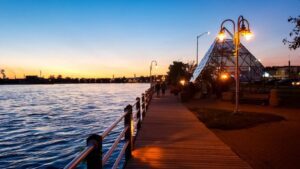
Sault Ste. Marie is known for its rich history, with several historic sites and landmarks throughout the city. The Canadian Bushplane Heritage Centre, for example, showcases the history of bushplanes and their role in the development of Northern Ontario. The city is also home to the Sault Ste. Marie Canal National Historic Site was crucial in developing the North American fur trade.
In addition to its history, Sault Ste. Marie is a popular destination for outdoor enthusiasts, offering a variety of recreational activities such as hiking, fishing, and boating. The city is surrounded by several parks and natural areas, including the Algoma Highlands, known for its rugged landscapes and abundant wildlife.
Sault Ste. Marie also has a vibrant arts and culture scene, with numerous galleries, theatres, and festivals showcasing the work of local artists and performers. The city is home to the Art Gallery of Algoma, which showcases the work of Canadian artists, and the Algoma Conservatory of Music, which offers music lessons and performances.
Overall, Sault Ste. Marie is a must-visit destination for anyone seeking an actual Northern Ontario experience. With its rich history, abundant natural beauty, and vibrant arts and culture scene, it’s no wonder that the city is considered one of the crown jewels of Northern Ontario.
Why choose private campgrounds in Northern Ontario?
There are many benefits to choosing a private campground in Northern Ontario. First and foremost, these properties offer the peace and tranquillity you desire while camping. Not to mention, they usually have more amenities than public campgrounds, including showers and toilets. Plus, you can be sure that the staff is knowledgeable about the area and can provide you with all the information you need while camping. Lastly, private campgrounds often have lower rates than public campgrounds. So, if you’re looking for a great camping experience without breaking the bank, a private campground is the way to go!
What to Look for When Searching for a Private Campground?
When searching for a private campground in Northern Ontario, there are a few things you should look for. The first is accessibility. Ensure the campground is close to major attractions or towns so you can quickly get to your adventures. Another critical factor to consider is the size of the campground. Some larger campsites have more amenities than smaller ones, so it’s worth checking out both options before making a final decision. And finally, make sure the campground has enough space for your group – not all campsites are designed for large crowds!

The Types of Campgrounds
Northern Ontario offers many camping options for those looking to escape the hustle and bustle of city life. Whether you are looking for a secluded spot on a remote lake or want to explore some of the province’s natural wonders, there is a campground. Here is a breakdown of the different types of campsites you can find in Northern Ontario:
Public Campgrounds
Public campsites all over Northern Ontario offer many amenities, including water, toilets, and showers. Some public campsites also have food outlets and playgrounds, while others offer basic camping facilities. All public campgrounds require a permit and should be booked in advance.
Reservable Campgrounds
Reservable campsites are perfect for those who want to enjoy nature without worrying about crowds or noise. These campsites are usually located near lakes or rivers and can only be reserved by phone or online. Campsites Reservable campsites generally offer more privacy than public campsites, but they may also be less well-maintained
Private Campgrounds
Private campgrounds are perfect for those who want to enjoy nature but don’t want to spend the night in a tent. These campsites usually offer basic facilities such as toilets and access for RVs, but some also have cabins or well-equipped bungalows.
Camping Tips & Gear
A common misconception about camping is that you must be fully equipped in the wilderness with everything “from A to Z.” You don’t need fishing gear, tennis rackets, or binoculars when camping. Enjoy nature without being attached to all the bulky equipment that might not fit into your backpack! If you camp at a public site or reservable campsite and do not have much space in your car or camper, setting up the tent and campground equipment inside the vehicle before you arrive is best.
This will give you extra room to move around while organizing and setting up your gear. If you are bringing a canvas-topped wagon or carry-on bag, bundle everything together with a rope that can be attached to an outside handle on the side of the vehicle and still be easily secured. If you’re using a backpacking tent instead of a travel tent, try to bring the bags with you since storing them in one place is more accessible than having them scattered throughout your vehicle.
Also, if you’re not camping near water where you can fill up at a nearby river, try to bring along water bottles that can hold enough water for the trip. Pre-staging your items in a central location will help ensure everything is visible and accessible, especially on the trail. We recommend putting everything you need into your pack or duffel bag at least two days before you leave (leave some space for miscellaneous items).
It’s best to test out your gear when possible, too, as different people have different preferences concerning how they like certain things organized. Once ready to set off, unpack your bag and begin sorting through it. When we hike, we don’t want to be weighed down by excess gear that doesn’t fit well with our hiking style. Packing light means taking the items most important to us and being prepared for anything the trail throws our way. To keep a load light—and get more stuff in our packs—we always pack in the same order: clothing, toiletry items, food, water, first aid kit, repair kit, sleeping bag/hammock, tent/tarp/bivy sack/hammock (depending on weather conditions), tent repair kit (if necessary), stove setup & fuel (if appropriate), and headlamp.
Preparation is essential before leaving home to ensure a smooth and enjoyable trip each time. For trails of any length or difficulty level, we recommend planning and learning about our environment and the trail or route you’ll be travelling on before heading out. For example, Go online and check for upcoming weather reports for the area. Check with local contacts and organizations. Take a hike in the region beforehand to familiarize yourself with terrain, wildlife, vegetation and plants—and most importantly—how to behave around them.
Do anything else you can think of that will enhance your trip! In addition, it helps to review our packing list below before every trip. Here is a list of what we always pack when we travel in our BYOGs: We always pack two extra sets of clothes for each person (including outerwear) in addition to what we have on. The two sets are identical, so while one travels, they can change into their spare set during the day. Generally, we keep one set in each of our backpacks. If you like a bit more summer weather in the mornings and a bit of fall and winter weather at night—and to be able to swap out layers as needed—we recommend packing wool sweaters, fleece jackets and waterproof outerwear.
For layering purposes, you will want to blend wool with other textiles (cotton or cotton/poly). We have found that if we wear a fleece jacket on top of a wool sweater, we get too hot when hiking in the heat of midday, but if we wear all three together without any extra layers ( or if it’s more relaxed and we have a wool base layer), we stay calm. To keep your gear in good working order if you use a pack, store it well. KEEP IT CLEAN! You don’t want the contents of your package to become stained due to contamination from your backpacking excursions.
We try to put our food in a zip-lock bag before packing it, but sometimes, we forget and end up with wet food at the bottom of our packs. We also learned that if you purchase cheap equipment (like most do), pay attention, as you may need to replace those items quickly. For example, the straps on our backpacks frayed almost immediately and began tearing in half while we were in the field.
That was a $200+ item that wasn’t made to handle such use, and we learned our lesson. If you’re going to backpack in the woods, you will destroy your gear or at least break it down. We’ve had to replace our backpack straps, sleeping pads (2 times), tent poles (2 times), tent stakes (4 – 5 times), sleeping bag zipper pull clips (once), gloves (once), my personal favourite: My hiking poles! They’re still usable, but I broke them when I hit a giant boulder and lost control.
How do you find a Destination on the Map?
When looking for a place to camp in Northern Ontario, it is essential to familiarize yourself with the local geography. Many private campgrounds are scattered throughout the region, but it can be challenging to determine which ones are worth exploring. To make your search easier, we have compiled a list of tips that will help you find the perfect spot.
To begin with, you’ll want to assess your camping needs. Are you looking for a place to pitch a tent or stay in a cabin? Do you need access to water or electricity? Once you’ve determined your needs, you can explore the online Campground Directory. This website contains comprehensive information on every private campground in the region, including amenities, fees and map coordinates.
Once you’ve selected a destination, check the weather forecast. Many of Northern Ontario’s private campgrounds are remote, and inclement weather can quickly turn unfavourable. Also, be prepared for bugs! Although many of Northern Ontario’s campgrounds are near bodies of water, mosquitoes can still be a problem at some campsites.
The Most Common Types of Campgrounds
If you’re interested in weekend camping in Northern Ontario, you’ll want to know the available campgrounds.
The most common type of campground in Northern Ontario is a provincial park. The government manages provincial parks and offers many facilities and activities, from swimming in lakes to hiking in the woods.
Another common type of campground is a private campground. Individuals or businesses operate private campgrounds, usually much smaller than provincial or national parks. They typically don’t offer as many amenities as provincial or national parks, but they’re perfect for those who want more privacy.
Finally, there are city-owned campgrounds. These campsites are usually located near major urban centres and offer many of the same amenities as private campgrounds, but they’re less likely to be open during peak tourist season.
Benefits of Camping in Private Campgrounds
More amenities and services: Private campgrounds in Northern Ontario often offer a wide range of amenities and services to enhance your camping experience. These include clean washrooms, hot showers, laundry, electrical hookups, Wi-Fi access, and swimming pools. These added comforts make it easier for families and those new to camping to enjoy the great outdoors.
Well-maintained sites: Private campgrounds pay special attention to maintaining their sites and facilities. Campsites are often level and spacious, allowing for easy setup of tents or RVs. Additionally, private campgrounds typically have groomed walking trails, picnic areas, and playgrounds, making it more convenient for visitors to relax and enjoy their surroundings.
Peace and privacy: Private campgrounds tend to be quieter and offer more privacy than public campgrounds. With fewer campsites and more space between them, you can enjoy a peaceful and secluded camping experience. This is especially appealing for those seeking solitude and a break from the hustle and bustle of daily life.
Activities and events: Private campgrounds often organize various activities and events for their guests. These include guided hikes, birdwatching tours, fishing tournaments, and evening campfires. Participating in these activities excites your camping trip and provides opportunities to meet and connect with fellow campers.
Convenience: Private campgrounds are usually located near popular tourist destinations and attractions such as hiking trails, lakes, and historic sites. This means you can easily explore the beauty of Northern Ontario without having to travel long distances from your campsite. Some private campgrounds have on-site stores where you can purchase camping essentials, snacks, and firewood, saving time and effort.
Knowledgeable staff: Private campgrounds often have friendly and experienced staff knowledgeable about the local area. They can recommend nearby attractions, outdoor activities, and popular hiking trails. Their expertise ensures you make the most of your camping adventure and discover hidden gems you might have missed.
Extended season: Private campgrounds in Northern Ontario often have longer camping seasons than public campgrounds. Some may offer year-round camping, allowing you to enjoy the region’s beauty even during the off-season. This is particularly appealing for those who prefer quieter camping trips or enjoy winter activities such as snowshoeing and cross-country skiing.
Contact information and websites
Contact information:
-The Ministry of Natural Resources website offers a searchable map of Ontario’s public and private campgrounds
-Ontario Parks also maintains a website with a list of private campgrounds in the province
-The Ontario Campground Association website also has a list of private campgrounds across Ontario
-Camping World Canada has an online directory of private campgrounds across Canada -The Private Campgrounds of Canada website is for private campgrounds, RV parks and reserves.-For more information on campgrounds and RV parks in Ontario, visit the Ministry of Natural Resources website at www.ontario.ca/mnr- For information on individual parks, visit the Parks Ontario website at www.parksontario.com -Find a place to park your RV: Find a Park Find an RV Park -Or contact an authorized camping provider in your area directly by searching online or calling them at 1-800-565-3472 or emailing info@campgroundlink.com
OR
Ontario Campground Association (OCA)
OCA is one of North America’s most active and comprehensive camping industry trade associations. Its members include campgrounds and RV parks, ranches, resort properties, and other facilities that provide camping opportunities for over one million recreational visitors annually in Ontario.
Visit the OCA website at www.ontariocampgroundassociation.com -Find a place to park your RV: Find a Park Find an RV Park -Or contact an authorized camping provider in your area directly by searching online or calling them at 1-800-565-3472 or emailing info@caplinks.ca
Map
FAQ
What amenities do private campgrounds in Northern Ontario typically offer?
Most private campgrounds in Northern Ontario offer a range of amenities such as electrical hookups, showers, washrooms, water stations, fire pits, and picnic tables. Some private campgrounds also offer additional facilities like swimming pools, playgrounds, on-site stores, laundry facilities, boat rentals, and Wi-Fi.
What kind of camping options can I expect at private campgrounds in Northern Ontario?
Private campgrounds in Northern Ontario offer various camping options, including tent sites, camper cabins, RV sites, seasonal sites, and backcountry camping.
Are private campgrounds in Northern Ontario open year-round?
No, not all private campgrounds in Northern Ontario are open year-round. Many of them operate from May through September, while others may offer extended seasons or winter camping options. Be sure to check with the individual campground for specific dates and availability.
Can I book campsites in advance at private campgrounds in Northern Ontario?
Yes, many private campgrounds in Northern Ontario allow you to book campsites in advance, either online or by phone. You should book your site(s) well in advance, especially during peak season (July-August).
Are pets allowed at private campgrounds in Northern Ontario?
Most private campgrounds in Northern Ontario allow pets, but there may be restrictions on specific park areas or special rules regarding leash requirements and waste cleanup. Always check with the individual campground for their pet policy before booking your stay.
What kind of activities can I enjoy at private campgrounds in Northern Ontario?
Private campgrounds in Northern Ontario offer many activities, including hiking, fishing, boating, swimming, kayaking, canoeing, wildlife viewing, birdwatching, cycling, and more. Many campgrounds provide organized events and activities for families and children, such as games, crafts, and movie nights.
Are there any special rules or regulations I should know when camping at private campgrounds in Northern Ontario?
Yes, each private campground may have rules and regulations regarding quiet hours, fires, alcohol consumption, and general behaviour. Be sure to familiarize yourself with the rules and follow them during your stay to ensure a safe and enjoyable experience.
Conclusion
If you’re considering a trip to Northern Ontario’s private campgrounds, there are a few things you need to know beforehand. First and foremost, these campsites are located in some of Canada’s most beautiful areas. However, because they are privately owned and operated, there can be restrictions on what you can and cannot do while visiting. Ensure you read the rules carefully before booking your trip so that you don’t run into any trouble during your stay.
- Yonge-Dundas Square in Toronto is Now Called “Sankofa Square” - December 17, 2023
- Best Western Brooks’ SureStay Plus debuts in Alberta - December 16, 2023
- Air Canada Arrives in Tulum, Mexico as the First Canadian Airline - December 16, 2023
